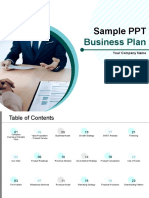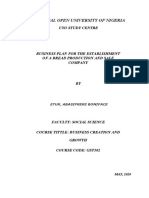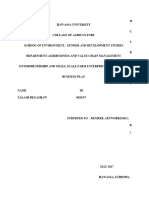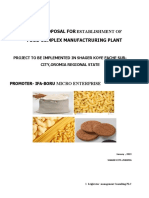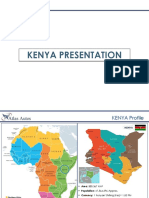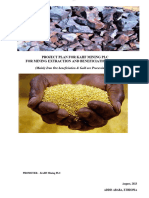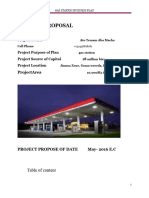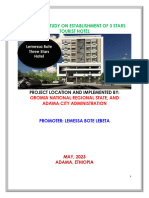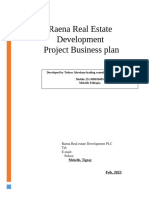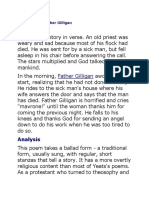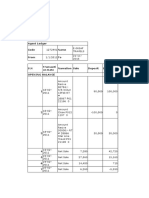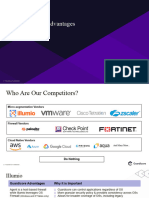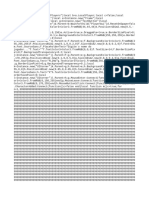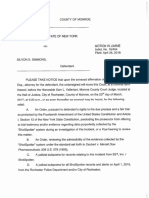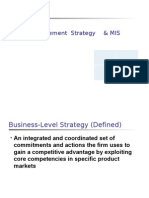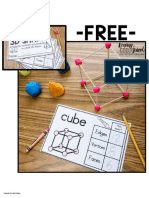ColorCity Flour-Mill
ColorCity Flour-Mill
Uploaded by
ANM Azam MehrabCopyright:
Available Formats
ColorCity Flour-Mill
ColorCity Flour-Mill
Uploaded by
ANM Azam MehrabOriginal Description:
Copyright
Available Formats
Share this document
Did you find this document useful?
Is this content inappropriate?
Copyright:
Available Formats
ColorCity Flour-Mill
ColorCity Flour-Mill
Uploaded by
ANM Azam MehrabCopyright:
Available Formats
Feasibility Report on ColorCity Flour Mill
The Project Profile
Prepared By:
ANM Azam Mehrab
CEO
ColorCity Flour Mills
Rangpur
ANMA Mehrab 1 2010
Feasibility Report on ColorCity Flour Mill
TABLE OF CONTENTS
Sr# Name Page No
1 PROJECT SUMMARY 1
2 ASSUMPTIONS 8
3 EXECUTIVE SUMMARY 9
4 MANAGEMENT 10
5 Estimated Cost of Land 11
6 Estimated Cost of Civil Works 11
7 Estimated Cost of Machinery 12
Estimated cost of the Project and interset during
8 13
construction
9 Initial Net Working Capital Requirement 14
10 Estimated Income Statement 15
11 Production at 100% Capacity 16
12 Capacity Utilized 17
13 18
Raw Material:
14 18
Estimated Cost of Labour
15 19
Year Wise Wages of Labor:
16 20
Manufacturing Overhead Cost:
17 21
Administrative And General Expenses
18 22
Year Wise Administrative Salaries:
19 23
Year Wise Depreciation:
20 23
Pre-Production Expenses:
21 24
Cash Flow Statement
22 25
Balance Sheet
Calculation of Internal Financial Rate of Return
23 26
and Loan Repayment Schedule
ANMA Mehrab 2 2010
Feasibility Report on ColorCity Flour Mill
24 Financial ratios 27
25 28
Financial Plan
27 Market Analysis 29
28 30
Technical Analysis
29 31
Manufacturing process/flow chart/diagram
30 33
Personel Analysis
31 34
SWOT Analysis
32 35
List of Machinery
33
Conclusion and Recomendations
34
Special Thanks
ANMA Mehrab 3 2010
Feasibility Report on ColorCity Flour Mill
PROJECT SUMMARY
Name of Project. Unitied Flour Mills
Location. Small industries estate bahawalpur
Nature of Industry. Flour Mills - A new Project
Product range Flour,Maida and bran
Installed Capicity 8 body flour mill
1.M.FARHAN KHIZAR
2.Amir Fraz
3 humaira kanwal
Purpose of Loan. To meet the Capital cost of the Project.
Machinery would be purchased from local
Brief Description of Ma
suppliers of machinery having good reputation in
chinery
market in this regard.
Estimated cost of the project Debt
60%
40,687000
Eqyity
40%
27,125000
total
67,812000
Names of loans Picic
Long term loan
Name of civil contractor
Name of machinery supplier M younas malik
Satluj industries
Small industries estate shop 5’6
Cell no: 03017711033
ANMA Mehrab 1 2010
Feasibility Report on ColorCity Flour Mill
Introduction
Wheat is one of the most important products for all of region of the world. Without wheat
human life is uncompleted. It is become more important not only by the fact of
improvement international value. It’s a first food item that an important for all over the
world. That business also important for a Pakistan. And last decades the flour mill are
increase due increase in demand of flour.
Reasons for Motivation
1. Availability of raw material
2. Availability of utilities
3. Availability of labor
4. Technical facilities
5. Whole year producing process
6. Large demand of the people.
7. Profitable Business
Proposed Location
The most feasible location for the plant would be in or near the wheat producing regions
of Punjab. This is advisable as transportation costs would be reduced and contact with
growers/farmers directly can be made. It is usually the case that the farmers are willing to
approach the manufacturing plant directly if it is located near to their lands. However, the
availability of trained personnel in the locality has to be kept in mind as well as the
availability of suitable residences because costs could rise if there was a problem in the
accessibility of the location from other urban area.
Decide Location
When we make investment and open a plant than we first decide the location and study
some regard about the location. The best location of any plant is important and greater
ANMA Mehrab 2 2010
Feasibility Report on ColorCity Flour Mill
effect on business. The business can run if all input is available. We decide location the
small industrial area of Bahawalpur followings factor should be examined.
1. Availability of raw material
The location that we decide, in that location the raw material of our plant is available.
And we also examined the input constraint. And study any short and fall of raw material
and how we can avoid that.
2. Availability of utilities
After the analyses of the raw material then we examine the utilities. For example power
water telecommunication road and other facilities. If the all facilities are available than
open a project other wise rejects.
3. Availability of labor
Then we examine labor. The workers are available for running a project.
• Available of skilled labor.
• Available of unskilled labor.
• Wage rate.
• Training of employees.
Nature of the Business
The nature of the business is partnership. Although selection totally depends upon the
choice of entrepreneur. This business is based on the partnership and registered under
partnership act 1932.
Name
We decide that the name of our flour mill is Bahawal Flour Mill.
Covered Area
ANMA Mehrab 3 2010
Feasibility Report on ColorCity Flour Mill
The total area, which we want to establish a Flour mill, is 2 acres. The cost of one acre is
5million. The area required to the machinery building is 2kenal.
Human Resource Required
Labor
There are three types of the labor are required
1. Technical Labor
2. Supervisors
3. Loaders
Technical Labor
Technical labor is a permanent employee of the factory. 15 to 20 employees are required.
1. Miller.
2. Manager.
3. Shift Incharge.
4. Rule man.
5. Washer Man.
6. Silk Man.
7. Accountant.
8. Packers.
9. Others Helper.
Supervisors
These are also the permanent employee of the factory.10 to 15 employees are required.
Loaders
Loaders are the contractor employee of the company. 15to20 employees are required.
What legal aspects do I need to consider while starting my business?
ANMA Mehrab 4 2010
Feasibility Report on ColorCity Flour Mill
While starting your business, government regulations need to be considered. These
regulations may also cover special incentives offered by the government for that
particular sector and other laws that may govern the business. You also must decide
about the form of your organization (sole proprietorship, partnership etc). Establish Flour
Mill following legal procedure is follows.
Legal Procedure
Application for license to Establish Flour Mill
Applications for licenses shall be made in Form “B” (annexed herewith as annex “A”) to
the Licensing Authority of the district in which the applicant carries on or intends to carry
on business involving the purchase, sale or storage for sale of food grains in wholesale
quantities. To obtaining license applicant have to undertake on the application Form that
he agrees to abide the conditions of license given in Form “A” (annexed herewith as
annex “B”). If any applicant carries on such business or intends to carry on such business
in more than one district he shall apply to the District Magistrate of the district in which
he usually resides. A single application may include a request to carry on business in a
number of districts.
APPLICATION FORM FOR LINCENSE
1. Applicant's name.
2. Applicant's profession.
3. Applicant's residence.
4. Situation of applicant's place(s) of business with full particulars regarding the number
of house or premises, which he wants to get this license.
5. Place (s) of storage.
6. How long has the applicant been trading in food grains mentioned in the Schedule I to
this order and any other food grains.
7. Quantities of foodgrains handled annual during the past three years.
8. Food grains in respect of which license is required.
ANMA Mehrab 5 2010
Feasibility Report on ColorCity Flour Mill
9. I have carefully read the conditions of license given in Form 'A' in Schedule II
appended to the West Pakistan Foodgrains (Licensing Control) Order, 1957 and I agree to
abide to them.
Date…………………….. Signature of the applicant.
9. Issuance of License
On receipt of application and on payment of a license fee of Rs. 10 for one district and
Rs. 2 for each subsequent district the licensing authority shall issue license.
10. Renewal of License
A license granted under this order shall, unless suspended, withdrawn or cancelled
continue to be in force for one year from the date of the issue of the said license but shall
be renewable annually by the licensee to the licensing authority by which the license was
granted and on payment of the renewal fee of Rs. 5 for the first district and Rs. 1 for each
subsequent district. Renewal of licenses shall be granted on the Renewal Endorsement
Form shown in Form “C” (annexed herewith as annex “D”). If any person fails to apply
and to deposit the renewal fee before the date when it is due to expire the license shall not
be renewed
Unless: -
A. the licensing authority is satisfied that there were good and sufficient reasons for the
delay; and
B. the licensee pays an extra fee of Rs. 5 for the first district and Rs. 1 for each
subsequent district.
11. Duplicate License
In the case of lost or damage of the license, a duplicate license shall be issued on payment
of Rs. 5 for one district and Rs. 1 for each subsequent district when it is proved to the
satisfaction of the licensing authority that the original license was lost or damage in a
bona fide manner.
ANMA Mehrab 6 2010
Feasibility Report on ColorCity Flour Mill
No Objection Certificate. (NOC)
After the issue of license the owner get the No Objection Certificate (NOC) from the
following department.
1-Industry Department
2- Environment Department
After the issue of (NOC) the owner starts the business properly.
No Objection Certificate Fee. (NOC)
No Objection Certificate Fee (NOC) pay the to the Industry Department and Environment
Department is Rs.25000
Food Department
Food Department gives the permission of quota of wheat on the base of urban bodies live
in the district.
ANMA Mehrab 7 2010
Feasibility Report on ColorCity Flour Mill
ASSUMPTIONS
1. Direct labour will increase every year 20%.
2. Administration salaries will be increase 20% per year.
3. Selling expense are 5% of sales revenue.
4. Depreciation will be constant over the life of assets.
5. The economic life of the project would be 10 year.
6. The entire capital outlay would be incurred one year prior to the
commencement of commercial operation.
7. Motor vehicles, furniture, fixtures, and equipments would be replaced
after 10 years.
8. Salvage value at the end of the life of the project represents recovery
of working capital original value of land, book value of land and book
value of building.
ANMA Mehrab 8 2010
Feasibility Report on ColorCity Flour Mill
EXECUTIVE SUMMARY
We are the fresh graduates of MSc A/c & Finance double specialization.
We are going to start a new business. We have made a research and seek
different type of investment opportunities in Bahawalpur region. As
Bahawalpur is an agricultural area having two major crops wheat and
cotton. We have decided to invest the flour mill because there is much
potential in this business and raw material is easily available.
As population is increasing day by day so the demand of flour is increasing
day by day so it is a very profitable project and it will contribute in the
industrial sector of Bahawalpur region.
United Flour Mill is a registered firm established with the objective of
providing flour and to fulfill the increasing demand of Bahawalpur region.
The two buy products are Maida and Bran. The mill is intending to starts it
operations initially with one plant in Chak 12BC Yazman road Bahawalpur.
It plans to expand its network latter in others Tehsils of Bahawalpur.
Initially United Flour Mill operates at 75% of the capacity. United Flour
Mill will starts its operations in September 2010.
ANMA Mehrab 9 2010
Feasibility Report on ColorCity Flour Mill
MANAGEMENT
1. Mr. Amir Fraz CEO
2. Mr. Farhan Khizar GM
3. Miss. Humaira kanwal MD
ANMA Mehrab 10 2010
Feasibility Report on ColorCity Flour Mill
Annexure - I
UNITED FLOUR MILL
Estimated Cost of Land
Sr. Unit Rs
Description
No. Area in Cost ("000")
Total
Marlas Cost
1 Land 120 68,000 8,160
Registratioin & Legal Requirements 1% of cost of
2 Land 120 680 82
3 Stamp Duty 2% of Cost of Land 120 1,360 163
4 District Council Fee 1% of Cost of Land 120 680 82
Total Cost of Land 8,486
Annexure - II
UNITED FLOUR MILL
Estimated Cost of Civil Works
Type of Unit of Covered Rate Per Rs ("000")
Sr. No. Description
Building Construction area Unit Total Cost
1 Machinery Hall(4 floor) RCC Square feet 10,880 700 7,616
2 Ware House(single story) RCC Square feet 5,440 400 2,176
3 office RCC Square feet 2,720 550 1,496
4 garage RCC Square feet 2,720 350 952
5 mchinery store RCC Square feet 2,720 350 952
6 work shop RCC Square feet 2,720 350 952
boundry wall 1 130000 130
main gate 1 30000 30
Total Cost of Civil Works 9,792
ANMA Mehrab 11 2010
Feasibility Report on ColorCity Flour Mill
UNITED FLOUR MILL
Estimated Cost of Machinery
Rupees ("000")
Sr.No. Description Qty Unit Cost Total Cost
Grinding Section
1 Ruler bodies(USSR type)(1000mm Ruler size with ruler) 8 700,000 5,600
2 Plant Shifter(4 Section each) 4 470,000 1,880
3 Bran Finisher 1 255,000 255
4 High Pressure Suction Fan 1 300,000 300
5 Battery Cyclone 1 300,000 300
6 Air lock with Cyclone with Dividing Walls 20 155,000 3,100
7 Main Pipe(size 24inch,lenth 50feet) 2,300
8 Purification Machine 1 450,000 450
9 Low Pressure Suction Fan 1 200,000 200
10 Cyclone with Pipe(size 4*8) 1 200
11 Flour,Maida,sujji,Chollar Packing Bin(Steel) 8 155,000 1,240
12 Conveyor Werm 9" Size(feet) 2000 1,000 2,000
13 Lift Pipe(4 inch with band,8 gage) 1500 1,000 1,500
14 Ruler Body Receiver with Happer 20 5,000 100
15 Production Pipe(5 inch, 16 gage) 1500 500 750
Cleaning Section
1 Washing Machine Full Size USSR type Steel 1 550,000 550
2 Elevators with belt with bucket 56 feet length 5 312,000 1,560
3 Seperater Polland Type 4 300,000 1,200
4 Scorer 2 270,000 540
5 Suction Fan with Cyclone with Suction Pipe 4 325,000 1,300
6 Cocle Salender Polland type 2 550,000 1,100
Others
Nut Bolt,Angle,Steel Sheet,Belt,Steel Jalli,Resham Jalli,etc 100
Total Cost of Machinery 26,525
ANMA Mehrab 12 2010
Feasibility Report on ColorCity Flour Mill
Annexure - III
UNITED FLOUR MILL
Estimated cost of the Project
Sr.No. Description LCY FCY Total cost ("000")
1 Land 8,486 - 8,486
2 Building 9,792 - 9,792
3 Machinery 26,525 - 26,525
4 Installation & Erection of Machinery 5,305 5,305
5 Insurance 10% of Cost of Machinery 2,653 2,653
6 Transportaion 10% of Machinery 2,653 2,653
7 Vehicles 1,400 1,400
8 Furniture and Fixture 900 900
9 Office Equipment 3,320 3,320
10 Pre-operating expenses 2,580 2,580
11 Interest during construction 1,846
Estimated fixed cost - 65,459
Add: Net Initial Net Working Capital 2,352
Total Estimated Cost of Project 67,812
interest during construction "000"
total cost of project 67812 interest
loan loan 40687 60% 1845.964
equity 27125 40%
interest during construction 1846
ANMA Mehrab 13 2010
Feasibility Report on ColorCity Flour Mill
UNITED FLOUR MILL
Initial Net Working Capital Requirement
Rs. "000"
A. Current Assets:
1 Inventories:
a) Raw Material 5 Days Requirement:
I)Wheat 134
b) Finished Goods 2,721
Total Cost of Inventory 2,855
2 Advances and Deposits, & Prepayments 4
3 Accounts Receivables (2% of Sales) 1,613
4 Cash 1% of Amount withdrawn from Bank for Inventory 21
Total Current Assets 4,494
B. Possible Current Liabilities:
Less: Bank Borrowing 75% of Inventories 2,141
Initial Net Working Capital 2,352
ANMA Mehrab 14 2010
Feasibility Report on ColorCity Flour Mill
Annexure-VI
UNITED FLOUR MILL
Estimated Income Statement
Years ending September 30 : 2009 2010 2011
Sales 80,669 95,010 100,985
COST OF SALES
Raw Material 16,536 17,633 18,742
Labor 15,439 18,527 22,232
Manufacturing Overheads 22,450 23,356 24,263
Depreciation 2,576 2,576 2,576
Total Cost of Goods Manufactured 57,001 62,093 67,814
Inventory Adjustment - Less 5,700 509 6,272
Cost of Sales 51,301 61,583 61,541
Gross Profit 29,368 33,426 39,444
OPERATING EXPENSES:
Administrative Expenses 3,780 4,536 5,443
General Expenses 1,750 2,100 2,520
Seling Expenses 4,033 4,750 5,049
Total Operating Expenses 9,563 # 11,386 # 13,012
Operating Profit 19,804 22,040 26,431
OTHER EXPENSES:
Financial Charges on:
Long Term Loan 6,103 5,493 4,882
Amortization of Pre-Production Expenses 860 860 860
Total Other Expenses 6,963 6,353 5,742
Profit Before Tax and Worker's Fund 12,841 15,687 20,689
Profit/(Loss) Before Tax 12,841 15,687 20,689
Tax Provisions @ 40% 5,136 # 6,275 # 8,276
Net Profit 7,705 9,412 12,413
Ratios:
1 Gross Profit/Sales 36.41 35.18 39.06
2 OperatingProfit/Sales 24.55 23.20 26.17
3 Pre-Tax Profit/Sales 15.92 16.51 20.49
4 Net Profit/Sales 9.55 9.91 12.29
5 Net Profit/Equity 22 21 22
ANMA Mehrab 15 2010
Feasibility Report on ColorCity Flour Mill
Annexure-VI-A
Production at 100% Capacity
Crushing Of Wheat:
6400kg Kg of Wheat/day/machine No. of Machines % Output Quantity (000)
Flour 1 80 256
Maida 1 10 32
Bran 1 10 32
Total 100 320
ANMA Mehrab 16 2010
Feasibility Report on ColorCity Flour Mill
Annexure-VI-A
Year ending 30th September:
2009 2010 2011
Capacity Utilized
75% 80% 85%
Quantity ("000")
Production of Flour:
a) Number of Units Manufactured 192 205 218
Add: Opening Inventory - 19 21
Total Units available for Sales 192 224 238
Less: Closing Inventory 10% of Production 19 21 22
Units Sold 173 204 217
Production of Maida:
b) Number of Units Manufactured 24 26 27
Add: Opening inventory - 2 3
Total Units available for Sales 24 28 30
Less: Closig Inventory 10% of Production 2 3 3
Quantity Sold 22 25 27
c) Production of Bran:
Number of Units Manufactured 24 26 27
Add: Opening Inventory - 2 3
Total Production available for Sales 24 28 30
Less: Closing Inventory 10% of Production 2 3 3
Quantity Sold 22 25 27
Sales Revenue:
Rupees
Description Unit Price
75% 80% 85%
a Flour 420 72,667 85,585 90,968
b Maida 250 5,407 6,368 6,768
c Bran 120 2,595 3,057 3,249
Total Sales (a+b+c) 80,669 95,010 100,985
ANMA Mehrab 17 2010
Feasibility Report on ColorCity Flour Mill
Annexure-VI-A
Raw Material:
Years 2009 2010 2011
Capacity Utilized
75% 80% 85%
Consumption of Raw Material:
Description Quanity ("000")
Wheat 6400kg/day/Machines 240 256 272
Cost of Raw material:
Description Rs. ("000")
Wheat @ 40/kg 9,612 10,253 10,894
Packing material 6,924 7,380 7,848
Total Cost 16,536 17,633 18,742
Annexure-VI-A
UNITED FLOUR MILL
Estimated Cost of Labour
Labour Cost:
a) Direct Labor:
No. of Salary/Month Annual
Sr. No. Milling Staff Employees /Worker Salary ("000")
1 Miller 1 35,000 420
2 Shift Incharge (Asst. miller) 1 25,000 300
3 Ruleman 2 20,000 480
4 Washing man 1 25,000 300
5 Silk man 1 22,000 264
6 Helper 8 24,000 2,304
7 Unskilled labour 12 25,000 3,600
Total 26 176,000 7,668
Add: Fringe Benefits (40% of Basic Salary) 3,067
Total Cost of Milling Staff 10,735
ANMA Mehrab 18 2010
Feasibility Report on ColorCity Flour Mill
No. of Salary/Month Annual
Sr. No. Office Staff & Production Staff Employees /Worker Salary ("000")
1 Manager 1 35,000 420
2 Accountants 2 25,000 600
3 Cashier 1 20,000 240
4 Production Clerk 2 23,000 552
5 Wheat Clerk 2 22,000 528
6 Field Supervisor 1 26,000 312
7 Gunman/Chowkidar 3 15,000 540
8 Peon 1 14,000 168
Total 13 180,000 3,360
Add: Fringe Benefits (40% of Basic Salary) 1,344
Total Cost of Office Staff & Production Staff 4,704
Assumptions:
1 Direct labor will increase every year @ 20%.
Year Wise Wages of Labor:
Years
Sr. No. Description
2009 2010 2011
Rs ("000")
1 Milling Staff 10,735 12,882 15,459
2 Office Staff & Production Staff 4,704 5,645 6,774
Total Cost of Labor 15,439 18,527 22,232
ANMA Mehrab 19 2010
Feasibility Report on ColorCity Flour Mill
Annexure-VI-A
Manufacturing Overhead Cost:
Description Rs ("000")
a) Fixed Cost:
Power: @ 288/400/KW/Month 2,765
Insurance: @ 10% of Fixed Assets Cost 4,923
Maintenance and Depreciation:
Overhauling Expenses @ 40000 Per machine 40
Maintenance of Building @ 10% of Cost of Building 979
Maintenance of Vehicles 10% of Cost of Vehicles 140
Total Fixed Cost 8,847
b) Variable Manufacturing Expenses:
Power: @ 7.71/unit of 400/KW/Month 85% of which will be utilized 18,119
Machinery Re. 3.00 Per 40/Kg on Crusing of wheat 18
Total Variable Cost 18,137
Year ending Manufacturing Overheads as per Different Capacities:
Years
Description 2009 2010 2011
Rupees ("000")
75% 80% 85%
Fixed Cost 8,847 8,847 8,847
Variable Cost 13,603 14,510 15,417
Total Cost of Manufacturing Overheads 22,450 23,356 24,263
ANMA Mehrab 20 2010
Feasibility Report on ColorCity Flour Mill
Annexure-VI-A
Administrative And General Expenses
Rupees ("000")
No. of Salary/ Annual
Sr. No. Designation
Employees Month Salary
1 Manager 1 40,000 480
2 Accountants 2 30,000 720
3 Production Clerk 2 20,000 480
4 Cashier 1 25,000 300
5 Chowkidar/Gunman 3 15,000 540
6 Peon/Sweeper 1 15,000 180
Total 9 145,000 2,700
Add: Fringe Benefits @ 40% 58,000 1,080
Total Cost of Administrative Staff 203,000 3,780
General Expenses:
Sr. No. Description Year Exp. ("000")
1 Travelling Expenses 300
2 Printing & Stationary 200
3 Telephone, Telex, Postage 250
4 Rents, Rates and Taxes 300
5 Entertainment 200
6 Legal & Audit 250
7 Miscellaneous 250
Total 1,750
ANMA Mehrab 21 2010
Feasibility Report on ColorCity Flour Mill
Year Wise Administrative Salaries:
No. of Rupees ("000")
Sr. No. Designation Employees 2009 2010 2011
1 Manager 1 480 576 691
2 Accountants 2 720 864 1,037
3 Production Clerk 2 480 576 691
4 Cashier 1 300 360 432
5 Chowkidar/Gunman 3 540 648 778
6 Peon/Sweeper 1 180 216 259
Total 10 2,700 3,240 3,888
Add: Fringe Benefits @ 40% 1,080 1,296 1,555
Total Administrative Salaries per Year 3,780 4,536 5,443
General Expenses:
Sr. No. Description Rupees ("000")
1 Travelling Expenses 300 360 432
2 Printing & Stationary 200 240 288
3 Telephone, Telex, Postage 250 300 360
4 Rents, Rates and Taxes 300 360 432
5 Entertainment 200 240 288
6 Legal & Audit 250 300 360
7 Miscellaneous 250 300 360
Total 1,750 2,100 2,520
Selling Expenses:
Selling Expenses are assumed to be 5% of Sales Revenue
Sr. No. Description Rupees ("000")
1 Selling Expenses 5% of Sales Revenue 4,033 4,750 5,049
ANMA Mehrab 22 2010
Feasibility Report on ColorCity Flour Mill
Annexure-VI-A
Depreciation Schedule of Fixed Assets:
Total Cost
Sr. No. Description (Rs.) Rs. ("000")
1 Plant & Machinery 37,135 1,857
2 Building 9,792 490
3 Vehicles 1,400 140
4 Furniture & Fixture 900 90
-
Total 49,227 2,576
Note:- Depreciation will be constant over the life of assets.
Year Wise Depreciation:
Years
Description
2009 2010 2011
Rupees ("000")
Depreciation 2,576 2,576 2,576
Pre-Production Expenses:
Sr. No. Description Rs. ("000")
1 Registration Charges 400
2 Sales Tax Registration Charges 300
3 Consultancy & Report Preparation Charges 350
4 Printing & Stationary 250
5 Conveyance Charges 280
6 Telephone & Postage 300
6 Salaries and Wages during Construction 700
Total Preproduction Expenses 2,580
ANMA Mehrab 23 2010
Feasibility Report on ColorCity Flour Mill
Annexure-
VII
UNITED FLOUR MILL
Cash Flow Statement
End of
Operating Years
Construction
years ending 30th September:
2008 2009 2010 2011
SOURCES OF FUNDS:
Operating Profits - 19,804 22,040 26,431
Add: Depreciation - 2,576 2,576 2,576
Total Funds from Operation - 22,381 24,616 29,008
Other Sources:
Long Term Loan 40,687 - -
Paid-Up Capital 27,125 - -
Total Sources of Funds 67,812 22,381 24,616 29,008
APPLICATION OF FUNDS:
Investment in Fixed Assets 57,713 - - -
Financial Charges during Construction 1,846 - - -
Pre-Production Expenses 2,580 - - -
Repayment of:
Long Term Loan - - 4,069 4,069
Bank Borrowings - - -
Financial Charges On:
Long Term Loan - 6,103 5,493 4,882
Bank Borrowings - -
PAYMENT OF:
Taxes - 5,136 6,275
Dividends - - - -
- - -
short term investment 3,000 - 5,000 10,000
Increase in Current Assets (Other than Cash) 138 4,811 573 438
Total Application of Funds 65,277 10,914 20,271 25,664
Cash Surplus/(Deficit) 2,535 11,467 4,345 3,344
Cash at the Beginning of the Year - 2,535 14,002 18,347
Cash at the end of the year 2,535 14,002 18,347 21,691
ANMA Mehrab 24 2010
Feasibility Report on ColorCity Flour Mill
Annexure-VIII
UNITED FLOUR MILL
Balance Sheet
End of
Operating Years
Construction
Year ending 30th September:
2008 2009 2010 2011
ASSETS: Rupees ("000")
CURRENT ASSETS:
Cash and Bank Balance 2,535 14,002 18,347 21,691
Short Term Investment 3,000 3,000 8,000 18,000
Accounts Receivable - 1,613 1,900 2,020
Inventories:
Wheat 134 481 513 545
Finished Goods - 2,850 3,105 3,391
Advances, Deposits and Prepayments 4 4 4 4
Total Current Assets 5,672 21,950 31,868 45,650
FIXED ASSETS:
Fixed Assets at Cost 59,559 59,559 59,559 59,559
Accumulated Depreciation on Fixed Assets - 2,576 5,153 7,729
Fixed Assets Net 59,559 56,983 54,407 51,830
Intangibles 2,580 1,720 860 -
Total Assets 67,812 80,653 87,135 97,480
LIABILITIES AND EQUITY:
CURRENT LIABILITIES:
Taxes Payable - 5,136 6,275 8,276
Dividend Payable - -
Worker's Fund Payable - - - -
Current Maturity of Log Term Debt - 4,069 4,069 4,069
Total Current Liabilities - 9,205 10,344 12,344
LONG TERM DEBTS:
Long Term Debt 40,687 36,618 32,550 28,481
Total long Term Debt 40,687 36,618 32,550 28,481
EQUITY:
Paid-Up-capital 27,125 27,125 27,125 27,125
Retained Earnings - 7,705 17,117 29,530
Total Equity 27,125 34,829 44,242 56,655
Total Liabilities and Equity 67,812 80,653 87,135 97,480
ANMA Mehrab 25 2010
Feasibility Report on ColorCity Flour Mill
Annexure - XII
UNITED FLOUR MILL
Loan Repayment Schedule
Opening Closing
Years Interest Principle
Balance Balance
1 40,687 6,103 4,069 36,618
2 36,618 5,493 4,069 32,550
3 32,550 4,882 4,069 28,481
4 28,481 4,272 4,069 24,412
5 24,412 3,662 4,069 20,344
6 20,344 3,052 4,069 16,275
7 16,275 2,441 4,069 12,206
8 12,206 1,831 4,069 8,137
9 8,137 1,221 4,069 4,069
10 4,069 610 4,069 -
Annexure-XI
UNITED FLOUR MILL
Calculation of Internal Financial Rate of Return
Capital Operating Worker's Net Cash Net Cash Inflow
Years Depreciation Taxes
Outlay Profit Fund Return (Outflow)
- 60,431 - - - - - (60,431)
1 4,811 19,804 2,576 22,381 17,570
2 573 22,040 2,576 - 5,136 19,480 18,906
3 438 26,431 2,576 - 6,275 22,733 22,295
4 - 26,431 2,576 - 8,276 20,732 20,732
5 - 26,431 2,576 - 8,276 20,732 20,732
6 2,300 26,431 2,576 - 8,276 20,732 18,432
7 - 26,431 2,576 - 8,276 20,732 20,732
8 - 26,431 2,576 - 8,276 20,732 20,732
9 - 26,431 2,576 - 8,276 20,732 20,732
10 - 26,431 2,576 - 8,276 20,732 20,732
IFRR 30%
ANMA Mehrab 26 2010
Feasibility Report on ColorCity Flour Mill
RATIOS
Netprofit margin ratio
net profit
net sale
year 2010 2011 2012
net profit 7704.727 9412.266 12413.34
sale 80668.71 95009.81 100985.3
net profit margin ratio 9.551073 9.906625 12.29223
Current ratio
current asst
current liability
year 2010 2011 2012
current asst 21950.04 31868.3 45650
current liability 9205.197 10343.56 12344.27
Current ratio 2.384526 3.080981 3.69807
Debt/equity ratio
total debt
totalequity
year 2010 2011 2012
total debt 45823.61 42893.26 40825.26
totalequity 34829.48 44241.74 56655.09
Debt/equity ratio 1.315656 0.96952 0.720593
Sponsors stake
27124.75
Amir fraz 10849.9 40%
Farhan khizar 10849.9 40%
Humaira kanwal 5424.95 20%
27124.75
ANMA Mehrab 27 2010
Feasibility Report on ColorCity Flour Mill
Annexure - XIII
UNITED FLOUR MILL
Financial Plan
Rupees ("000")
Description LCY FCY Total cost
Total Fixed cost of the project 65,459 - 65,459
Initial Permanent working capital 2,352 - 2,352
Total cost of the project 67,812 67,812
Long Term Debt 40,687 - 40,687
Equity Participation 27,125 - 27,125
Total Capital Required 67,812 67,812
Debt/Equity Ratio
Debt-to-Equity Ratio: 60 : 40
ANMA Mehrab 28 2010
Feasibility Report on ColorCity Flour Mill
Market Analysis
Brief description of market:
Like every other industry, milling is subject to increased market pressures.
Customers demand consistent quality and product variety while production
efficiency must be maintained if not improved. A FOSS solution can prove an
important ally in walking such a tightrope.
Pakistan has a rich and vast natural resource base, covering various ecological
and climatic zones; hence the country has great potential for producing all types
of food commodities. Agriculture has an important direct and indirect role in
generating economic growth. The importance of agriculture to the economy is
seen in three ways: first, it provides food to consumers and fibres for domestic
industry; second, it is a source of scarce foreign exchange earnings; and third, it
provides a market for industrial goods
Production in Pakistan for the last 5 years (000 tons):
2004-05 2005-06 2006-07 2007-08 2008-09
21612 21277 23295 20959 23421
Present demand:
Present demand of flour is about 25525000 tons in this current year.
Demand supply gap:
The supply of flour is about 23225000 tons and demand is about 25525000 tons.
Ex-factory price(price which u will sell to whole sellers)
The ex-factory price of 20kg bag of floure is 540
The ex-factory price of 20kg bag of maida is 740
The ex-factory price of 20kg bag of bran is 220
Retail price
The retail price of 20kg bag of floure is 560
The retail price of 20kg bag of maida is 760
The retail price of 20kg bag of bran is 240
ANMA Mehrab 29 2010
Feasibility Report on ColorCity Flour Mill
Distribution channel:
First of all our salse man collect the orders from whole sale dealers than from
whole sale dealer the shop keeper collect the flour than ultimate consumers
purchase from retail store
Strategic Recommendations
Initially, the product would be launched in the local market. The
preferred mode of distribution is going directly to the wholesalers.
There is an option of having no involvement of any distributor between
the manufacturer and the wholesaler in the city where manufacturing
is being done. By giving healthier profit margins to the wholesalers,
the wholesalers will hence promote the product. This strategy is
important to introduce such a product and to create an extensive
distribution and sales channel. The company will later expand into
other cities through a distributor network.
Technical analysis
Brief description of technical aspects:
There are five roll systems in a flour mill: break, sizing, midds (for middlings), low
grade, and residue.
In the break system, the kernel is opened, the bran flattened and the endosperm
broken into large chunks. Al-though some flour is produced here, the goal in the
break system is not to produce a lot of flour but to maximize separation of bran
from endosperm. Because the break rolls are at the beginning of the milling
process, the quality of the work done here effects each subsequent step, thus
determining both the yield of flour and the quality of that flour. If the rolls are too
aggressive, portions of the bran may be torn or ground into dust that will be
impossible to separate from the endosperm in later steps.
In the sizing system, rolls are used to further flatten and separate bran and germ
from the endosperm. Sizing rolls are either finely corrugated or smooth. Coarse
and fine sizings are produced on these rolls.
Most of the high quality flour is produced in the midds reduction system. Here the
rolls are either very finely corrugated or smooth.
ANMA Mehrab 30 2010
Feasibility Report on ColorCity Flour Mill
Each time stock passes between a pair of rolls, the resulting milled stock is run
through a purifier, primarily gyratory bolters with stacks of sieves with different
screen and cloth meshes. Vibration and air flow contribute to stratification and
separation of the material. The material which will pass through ("thrus") the
finest (bottom) sieve cloth in the purifier is flour. Each set of rolls thus has its own
flour "stream," identified by the roll the stock came from before arriving at the
purifier: 1st Break, 2nd Break, 1st Midds, Sizings, etc.
The "overs" of each sieve (particles not fine enough to pass through) are directed
to another set of rolls for further reduction, or to one of the residue streams: bran,
germ, shorts, or red dog. None of these end up in the flour. Indeed, any part of
the wheat that does not enter one of the flour streams will be one of these four
"by-products." These materials, unless there is a specialty market for them, are
generally sold as feedstock.
The separation by size, grade, etc. at each stage of the milling process creates
many dozens of "streams" which wind their way through the mill.
In the end, the various streams are blended and mixed to make various grades of
flour, then treated with the addition of malted barley, bleaching agents,
enrichments, etc. before packaging. If all the flour streams are combined and
blended, the resulting flour is "Straight Grade." 'Patent" is the flour from those
streams containing the least bran and germ particles, thereby the whitest and
lowest in ash. "Clear" flour, on the other hand, is from the "dirtier" flour streams.
While straight and clear flours will have more protein than the patent flour from
the same wheat on the same mill run, this additional protein is from the aleurone
and germ, not gluten from the endosperm.
Area we will cover:
Our flour mill established in bahawalpur. We can supply of flour in bahawalpur
division. There are three district in this region in which we will supply our
products.
ANMA Mehrab 31 2010
Feasibility Report on ColorCity Flour Mill
Manufacturing process/flow chart/diagram:
Wheat received
in the Factory
Wheat is weighted
on the Plate Form
Elevator 1 Elevator 2 Elevator 3 Elevator 4
Wheat goes to
Separators for
Clearing
Separator 1
Wheat goes to Bin
to send it for
Washing
Washing
Machine
Wheat goes to Bin
to send it for
Grinding
Roller Body
Sifter
Packing
Output is send
to Market
Separator 2
Separator 3
ANMA Mehrab 32 2010
Feasibility Report on ColorCity Flour Mill
3)Personnel analysis:
Factory staff:
S.NO Type of Number Basic salary Total
Staff required per Person, salaries per
per month year
1 skilled 14 30000 4068000
2 Un-skilled 12 25000 3600000
ADMINISTRATION AND GENERAL STAFF
No. of Salary/Month Annual
Sr. No. Office Staff & Production Staff Employees /Worker Salary ("000")
1 Manager 1 35,000 420
2 Accountants 2 25,000 600
3 Cashier 1 20,000 240
4 Production Clerk 2 23,000 552
5 Wheat Clerk 2 22,000 528
6 Field Supervisor 1 26,000 312
7 Gunman/Chowkidar 3 15,000 540
8 Peon 1 14,000 168
Total 13 180,000 3,360
Add: Fringe Benefits (40% of Basic Salary) 1,344
Total Cost of Office Staff & Production Staff 4,704
Assumptions:
ANMA Mehrab 33 2010
Feasibility Report on ColorCity Flour Mill
SWOT Analysis
Strengths:
The labor to manufacture flour is easily available we can reach easily to low cost labor.
Moreover the location for our project is very attractive. We can avail maximum
advantage from this market.
Weaknesses:
Our weakness is that we are not producing flour up to the present demand
of the consumer. Because we have dependend on govt for wheat and electricity problem
is also our weakness.
Opportunities:
Pakistan is an agricultureal country, the production of wheat is very high.flour is
neccessry for all kind of people so, demand of wheat is repedly increases.also there is no
enough flour mills to fullfill the demand so, there is great opportunity to establish flour
mill.
Threats:
Competitive Structure of the market
The market of the flour mills is highly competitive; therefore if the entrepreneur is
not well responsive and fulfilling the demand of the consumer he/she may not be able to
capitalize the opportunity properly.and the qotta system is used the supply of wheat not
provided to flour mills according to their demands.
ANMA Mehrab 34 2010
Feasibility Report on ColorCity Flour Mill
List of machinery
Now we will discuss the process of converting Wheat into Flour
There are two section of working area in the Hafiz flour mill
1. Washing section.
2. Grinding section.
Now we will discuss these sections and what is happening in these sections in
detail.
WASHING SECTION
There are few machineries are used for the processing of flour. We will
discuss these machineries in detail one by one. Following are the machineries.
1. SEPRATOR.
2. ELEVATOR.
3. SCOLDER MACHINE.
4. LOW PRESSURE FAN.
5. WASHING MACHINE.
6. STORAGE BIN.
7. MAGNETIC MACHINE.
ANMA Mehrab 35 2010
Feasibility Report on ColorCity Flour Mill
1. Seprator
separator is the first machine which is used in the washing section and the
person who operate this machine is roll man.
First when the wheat pool, there are lot of dust and mummnies in the wheat.
This machine’s main function is that to separate the dust and mummnies from
the wheat.
ANMA Mehrab 36 2010
Feasibility Report on ColorCity Flour Mill
2. ELEVATOR
Elevator is the machine which is help full for lifting the wheat at each section. it is
just like the lift and performing the same function of lift. There are two types of
elevator are used in the mill. First is traditional elevator and other is new
technological elevator. Traditional way is that the wheat is lift through the simple
belt.
ANMA Mehrab 37 2010
Feasibility Report on ColorCity Flour Mill
Scolder Machine.
With the help of elevator the wheat is shift to the scorer machine.The scorer
machine is one of the most important machines. The main function which is
performed by this machine is to put out the outer layer of the wheat. This is
necessary to understand that this machine put out the outer layer of dry wheat. It
is necessary that the wheat is dry at least twelve hours and then put into the
scorer machine.
ANMA Mehrab 38 2010
Feasibility Report on ColorCity Flour Mill
LOW PRESSURE FAN
Low pressure fan is the fan that pressurized the wheat for the purpose of
cleaning. This means that after outing the scorer machine some dust include and
this fan clean such dust. This fan is not too much power full as the high pressure
fan.
Low
pressure
Fan
ANMA Mehrab 39 2010
Feasibility Report on ColorCity Flour Mill
WASHING MACHINE
Washing machine acutely performs three types of functions.
1. Wash with water.
2. Further put out the outer layer
3. To put out the stones.
Wash with water.
This machine firstly washed the wheat through
the water after passing the water the wheat will be too much clean and then
transfer for further process.
Further putout the outer layer of wheat
After wash with the water wheat is transferred for again
thrashing. In during the trashing again put out the outer layer of wheat.
Put out the Stones
Washing machine also performs the function
to put out the stones from the wheat.
ANMA Mehrab 40 2010
Feasibility Report on ColorCity Flour Mill
Magnetic Machine
Magnetic machine is used to catch the iron particles included in the wheat. In this
machine magnets are installed which help to catch the iron particles.
ANMA Mehrab 41 2010
Feasibility Report on ColorCity Flour Mill
Grinding Section
Ruler Body
Ruler body is the machine through which grinding of wheat takes place. This is
the first step of grinding. Wheat comes after the washing section firstly put into
the ruler body for the grinding purpose.
ANMA Mehrab 42 2010
Feasibility Report on ColorCity Flour Mill
Shifter
The other machine which is used in the grinding section is the shifter.
This machine main function is that it shifts the flour into different categories.
Categories means that special type of flour is separate from the bran and suji.
There are separate boxes for each item.
ANMA Mehrab 43 2010
Feasibility Report on ColorCity Flour Mill
PURIFIER
Purifier machine is used to make the suji.It is independent from the shifter.purifier
has different boxes and each box has show different effect which means that
from one box wastage material is stored and other boxes are for the preparation
of suji.
ANMA Mehrab 44 2010
Feasibility Report on ColorCity Flour Mill
Air Lock
Air lock is used to cease the air because if the air is include in the production
then all the production may be destroy. So that’s why air lock is used to cease
the air.
ANMA Mehrab 45 2010
Feasibility Report on ColorCity Flour Mill
High pressure Fan
High pressure fan has a same function as the low pressure fan but the main
difference is that the high pressure fan has a high voltage power full machine.
ANMA Mehrab 46 2010
Feasibility Report on ColorCity Flour Mill
Battery Cyclones
Battery cyclones is also help full for the cleaning and it take the pressure from the
low pressure fan and the high pressure fan.
ANMA Mehrab 47 2010
Feasibility Report on ColorCity Flour Mill
Production worm
Production worm is the line through which the final product is being passed at
the packing room.
The above all the machinery is used to convert the
wheat into flour. The above is all the process of
production of flour.
ANMA Mehrab 48 2010
Feasibility Report on ColorCity Flour Mill
Conclusion and Recomendation
We conclude that on the basis of field work and surveu of flour
mills that the flour is neccessry product so its demand increse
day by day. There is no chance to decrease the demand of
flour. Pakista is an agricultural country and wheat is the one of
the major crop. Availability of raw material is very easy. So,
conclusion is that the flour mill is a profit motive business
because no chance of decrease of demand.
Our recommendation to new investors is that they must invest
in flour mill because from the last year there is the shortage of
flour in pakistan. So, they step forward to minimize this
shortage, and also contribute in the economic as well as social
groth of Pakistan.
ANMA Mehrab 49 2010
You might also like
- Aggregate Manufacturing FeasibilityDocument26 pagesAggregate Manufacturing Feasibilityabrham astatikeNo ratings yet
- Flour MillDocument58 pagesFlour Millshani2773% (15)
- Sample PPT Business Plan PPT PowerPoint Presentation Outline StylesDocument47 pagesSample PPT Business Plan PPT PowerPoint Presentation Outline StylesLiza Nashielly Grande100% (1)
- MRS Umoh Bread Business PlanDocument26 pagesMRS Umoh Bread Business PlanMAVERICK MONROE100% (1)
- Calls by Sister LuciaDocument203 pagesCalls by Sister LuciaPerez Fabiola100% (1)
- Wood PolesDocument30 pagesWood Polesbig johnNo ratings yet
- Project Profile On Flour MillDocument2 pagesProject Profile On Flour Millpradip_kumar100% (1)
- Hotel ProposalDocument14 pagesHotel ProposalAssefa MogesNo ratings yet
- Coastal Transport Corporation ProfileDocument10 pagesCoastal Transport Corporation ProfileSHAHARA ZAID MOLLERNo ratings yet
- Business Plan Feasibility Edna Mall Expansion Project ProposalDocument30 pagesBusiness Plan Feasibility Edna Mall Expansion Project ProposalShimels Shawel Zewudie0% (1)
- KeyruDocument22 pagesKeyrujemal kemalNo ratings yet
- The Ethiopian Pasta Production Is Booming: Macaroni and Spaghetti Are Pushed by The Increase of Durum Wheat ProductionDocument12 pagesThe Ethiopian Pasta Production Is Booming: Macaroni and Spaghetti Are Pushed by The Increase of Durum Wheat ProductionRabiaNo ratings yet
- NewplanDocument12 pagesNewplanmubeyinyenuriye100% (1)
- Abduselam Aliyi Project ProposalDocument67 pagesAbduselam Aliyi Project ProposalAbduselam AliyiNo ratings yet
- STEEL 1.5HEK Bishoftu Famet PLCDocument35 pagesSTEEL 1.5HEK Bishoftu Famet PLCRamon ColonNo ratings yet
- Eproject Proposal For Establishment of Food Complex Manufactruring PlantDocument44 pagesEproject Proposal For Establishment of Food Complex Manufactruring PlantTesfaye DegefaNo ratings yet
- Ethio Invest FACTOR COSTSDocument114 pagesEthio Invest FACTOR COSTSshika1983No ratings yet
- Marketing For LED and Music StuffDocument11 pagesMarketing For LED and Music StuffHanan BiyaNo ratings yet
- MESFIN HailemariamDocument29 pagesMESFIN Hailemariammuluken walelgnNo ratings yet
- Yohannes Business PlanDocument26 pagesYohannes Business PlansiinqeecreditNo ratings yet
- Kenya Lubricant MarketDocument7 pagesKenya Lubricant Marketwaseem bashirNo ratings yet
- Operations Management: Business Plan: Wheel Alignment - Balancing and Accessories & Tyres FittingDocument32 pagesOperations Management: Business Plan: Wheel Alignment - Balancing and Accessories & Tyres Fittingprashaant4uNo ratings yet
- Teshale Hotel Afar SemeraDocument55 pagesTeshale Hotel Afar SemeraBerihu Haftu100% (1)
- Project On Shopping MallsDocument38 pagesProject On Shopping Mallsdeep1aroraNo ratings yet
- FC Water CJDocument10 pagesFC Water CJSudhir MishraNo ratings yet
- Alemayehu MetallicDocument20 pagesAlemayehu Metallicmuluken walelgnNo ratings yet
- Jemal Hotel and Guest HouseDocument40 pagesJemal Hotel and Guest HouseRamon ColonNo ratings yet
- YENUS Flour FactoryDocument42 pagesYENUS Flour FactoryTesfaye DegefaNo ratings yet
- Cattle FatteningDocument44 pagesCattle Fatteningmaedot merkebNo ratings yet
- CO-VANCE (Metformin + Glibenclamide) Product PresentationDocument25 pagesCO-VANCE (Metformin + Glibenclamide) Product Presentationashe64h74No ratings yet
- Ethiopia Edible Oil Industry Mapping 2018Document24 pagesEthiopia Edible Oil Industry Mapping 2018Mehari GizachewNo ratings yet
- Document (2) Amenmen Brush and Broom Manufacturing Factory in EthiopiaDocument2 pagesDocument (2) Amenmen Brush and Broom Manufacturing Factory in Ethiopiagetachew liger100% (1)
- Tesfaye CorectttDocument4 pagesTesfaye CorectttTesfaye DegefaNo ratings yet
- Nokia FinalDocument22 pagesNokia FinalAyaz AliNo ratings yet
- Teshome HotelDocument12 pagesTeshome HotelMelat Makonnen100% (1)
- Project Report Palouge-2 - SudanDocument17 pagesProject Report Palouge-2 - SudanAmmara AliNo ratings yet
- MIXED-USE-BUILDIN TewodorsDocument47 pagesMIXED-USE-BUILDIN TewodorsTesfaye DegefaNo ratings yet
- Fitsum Rosemary Proposal 20220601Document40 pagesFitsum Rosemary Proposal 20220601Berhanu GumaraNo ratings yet
- Final Iron and Gold Ore Project PlanDocument16 pagesFinal Iron and Gold Ore Project PlanHabtu AsratNo ratings yet
- Rimbana GarmmentDocument41 pagesRimbana Garmmenteyobtech23No ratings yet
- Television Set Assembly PlantDocument28 pagesTelevision Set Assembly PlantAbebeNo ratings yet
- Fafa Food Factory PropDocument10 pagesFafa Food Factory PropHabtemariam GebrehiwotNo ratings yet
- Hafiza Kamil Gas Station ProposalDocument30 pagesHafiza Kamil Gas Station Proposalkamilreshad89No ratings yet
- NasruDocument24 pagesNasrugemechu100% (1)
- Executives Summary of ProjectDocument24 pagesExecutives Summary of ProjectgemechuNo ratings yet
- Lemessa Bote Three Star Hotel May 2023Document60 pagesLemessa Bote Three Star Hotel May 2023Beyene Tolera0% (1)
- Re, Ee ProjectDocument27 pagesRe, Ee ProjectSabrina Abdurahman100% (1)
- EIA Duresaa DDD RRDocument88 pagesEIA Duresaa DDD RRTesfaye DegefaNo ratings yet
- Review On Compound Animal Feed Processing in Ethiopia: Condition, Challenges and OpportunitiesDocument5 pagesReview On Compound Animal Feed Processing in Ethiopia: Condition, Challenges and OpportunitiesFeyisa Reta100% (1)
- Bidding Document (10-8-20)Document85 pagesBidding Document (10-8-20)natnael demissieNo ratings yet
- Overview of Risks & Opportunties of Furniture Store in EthiopiaDocument7 pagesOverview of Risks & Opportunties of Furniture Store in Ethiopiadavinder.continentalNo ratings yet
- PP Bag - GALAAN Na'olDocument47 pagesPP Bag - GALAAN Na'olRamon ColonNo ratings yet
- Real Estate Busness PlanDocument28 pagesReal Estate Busness PlanTedros AbrehamNo ratings yet
- 60 40 Corn Flake AxumDocument37 pages60 40 Corn Flake AxumAbrahamNo ratings yet
- Final Raval Steel Land Request Proposal (Submitted)Document32 pagesFinal Raval Steel Land Request Proposal (Submitted)Tesfaye Degefa0% (1)
- SMEDA Light Weight Roof Tiles Manufacturing UnitDocument23 pagesSMEDA Light Weight Roof Tiles Manufacturing UnitMuhammad AbubakarNo ratings yet
- Mango Flavored YoghurtDocument9 pagesMango Flavored YoghurtNeil Cedric Tabula Agustines100% (1)
- Feasibility Study On Vegetable FarmDocument32 pagesFeasibility Study On Vegetable FarmDawit TesfaNo ratings yet
- Investment Proposal For DireDocument16 pagesInvestment Proposal For DireAbdifetah HashiNo ratings yet
- Shaber GelanDocument49 pagesShaber GelanRamon ColonNo ratings yet
- MG GYpsum Final CatalogDocument16 pagesMG GYpsum Final CatalogabelNo ratings yet
- Profile On The Production of Electric Wires AndLV CablesDocument26 pagesProfile On The Production of Electric Wires AndLV CablesDagim GBZNo ratings yet
- The Ballad of Father GilliganDocument4 pagesThe Ballad of Father GilliganSaptarshi Pal100% (1)
- Agent Ledger Code FromDocument12 pagesAgent Ledger Code FromEmad RashidNo ratings yet
- Consumer Durable IndustryDocument20 pagesConsumer Durable Industryvipul tutejaNo ratings yet
- Roll No. Name Sub 1 Sub 2 Sub 3 Sub 4 Sub 5Document69 pagesRoll No. Name Sub 1 Sub 2 Sub 3 Sub 4 Sub 5Mayuri PratapNo ratings yet
- 1 s2.0 S095741741201250X MainDocument6 pages1 s2.0 S095741741201250X MainFaria RahimNo ratings yet
- 142 PCIC V Explorer MaritimeDocument4 pages142 PCIC V Explorer MaritimePaolo SomeraNo ratings yet
- A Class Contractor of Rajasthan ExtendedDocument69 pagesA Class Contractor of Rajasthan ExtendedNaman SinghalNo ratings yet
- Mr. G.A Waseem Mohamed: 075 8186962/0725670187 Job Objectives & Career GoalsDocument3 pagesMr. G.A Waseem Mohamed: 075 8186962/0725670187 Job Objectives & Career GoalsWaseem MohamedNo ratings yet
- Chestionarul Octombrie-10Document39 pagesChestionarul Octombrie-10Mircea Mihai DorinelNo ratings yet
- Pengembangan Media Pembelajaran Audio Berbasis Podcast Pada Materi Sejarah Lokal Di Sumatera SelatanDocument8 pagesPengembangan Media Pembelajaran Audio Berbasis Podcast Pada Materi Sejarah Lokal Di Sumatera SelatanNurLatifahMahfudzNo ratings yet
- Competitive AdvantegesDocument8 pagesCompetitive AdvantegesMarcos RonderosNo ratings yet
- Exercise. AdjustmentsDocument6 pagesExercise. AdjustmentsDavid Con Rivero79% (14)
- A16 GED109 Cabugawan - FilmAnalysisDocument2 pagesA16 GED109 Cabugawan - FilmAnalysisBang Bang BarilangangNo ratings yet
- CyberArk IssuesDocument3 pagesCyberArk IssuesMohan CNo ratings yet
- Eimi Weekly Vol 3 No 31Document2 pagesEimi Weekly Vol 3 No 31officena officenaNo ratings yet
- Katalog WebDocument60 pagesKatalog WebdragonralinNo ratings yet
- Admit CardDocument6 pagesAdmit CardIndira UNo ratings yet
- Minucher vs. Court of Appeals: 244 Supreme Court Reports AnnotatedDocument14 pagesMinucher vs. Court of Appeals: 244 Supreme Court Reports AnnotatedJelly BerryNo ratings yet
- FlingDocument4 pagesFlinghackersroblox66No ratings yet
- Marketing and The OrganizationDocument10 pagesMarketing and The OrganizationmikkelNo ratings yet
- Exemple Dintroduction de Dissertation JuridiqueDocument8 pagesExemple Dintroduction de Dissertation JuridiqueCustomizedWritingPaperEugene100% (1)
- BUSS 420 - New PDFDocument106 pagesBUSS 420 - New PDFPatriqKaruriKimbo100% (1)
- Shotspotter in Limine FINALDocument66 pagesShotspotter in Limine FINALFuzzy PandaNo ratings yet
- Strategic MisDocument58 pagesStrategic Missagar09100% (1)
- OCI Exam Preperation Handbook v2.0Document14 pagesOCI Exam Preperation Handbook v2.0Alfredo MirandaNo ratings yet
- Essence of Indian Traditional Knowledge Lecture Notes - by - SaraswathiDocument66 pagesEssence of Indian Traditional Knowledge Lecture Notes - by - Saraswathisanjayyalla4661100% (1)
- SolidosDocument11 pagesSolidosRaquel Correia de CarvalhoNo ratings yet
- The Search For The Primitive ChurchDocument28 pagesThe Search For The Primitive ChurchKovács Zoltán MihályNo ratings yet


